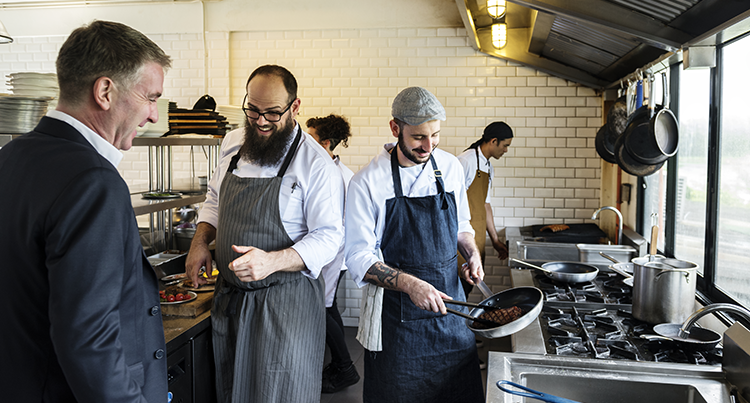For a business to function properly, time is always of the essence — and nowhere is that truer than in hospitality. Time management is a critical skill for any professional to develop, especially in the restaurant industry, where timeliness directly impacts service quality.
Research shows that restaurants that address punctuality in pre-shift meetings provide a better overall experience to diners. And when every department makes the most of their time, the entire restaurant runs smoothly.

In this blog post, we’re sharing effective time management skills for hospitality workers — including front-of-house (FOH), back-of-house (BOH), and restaurant management tips that will help your team succeed.
Why time management matters
The need for efficiency is universal — and in hospitality, it’s non-negotiable. Strong time management:
- Keeps service flowing and guests satisfied
- Reduces stress and burnout for staff
- Helps management balance labor costs and quality
A few minutes saved at every step can mean faster service, happier guests, and a more profitable restaurant overall.
Time management for Front-of-house staff
If you work front of house, you’re the face of your restaurant. Timing is everything when you interact with guests directly. Here’s how you can manage your time effectively as a server, host, or bartender.
1. Show up to shifts on time
Punctuality goes a long way in the service industry. On an individual level, showing up on time lets you prepare for your shift. On a team level, one tardy employee can throw off service time for everyone else — guests included.
💡 Prone to tardiness?
Trick yourself into thinking your shift begins earlier by adjusting your start time in your smartphone calendar or planner by 15–30 minutes. Even if you run behind your “new” start time, you’ll still be early or on time for work.
⚡ Manager tip:
Instead of micromanaging, use employee time management systems to track punctuality and identify recurring patterns. A friendly reminder early on prevents bigger issues later.
2. Pace yourself
As a server, you control not only your own time, but also your guests’ time. Pay attention to what guests communicate verbally and through body language. Are they in a rush, or do they want to linger?
Adjust your pacing — when you bring out courses, how often you check in, when you present the check — to suit their needs.
⚡ Manager tip:
Train your team on pacing techniques with Typsy’s course on effective time management skills for servers to improve guest satisfaction and workflow efficiency.
Time management for Back-of-house staff
Back-of-house employees are at the core of delivering the food experience diners crave. Plus, FOH staff rely on BOH staff to create a seamless overall experience. Here’s how to master time management as a chef, cook, or dishwasher.
1. Audit your workflow
Reevaluate your workflow and set priorities to take control of your time in the kitchen. Do you feel like ticket times keep growing? Are dishes piling up in the sink? Study your menu and process.
Time how long each task takes. For example, if salmon and roast chicken are ordered on the same ticket, which should be started first? Could you do extra prep before a shift to ensure faster ticket times during service?
⚡ Manager tip:
When onboarding new BOH team members, train them on efficient work processes. Small differences between restaurants can lead to big time savings when standardized.
2. Communicate with the front-of-house team
Even with efficient processes, things can still go wrong. A dish might burn, a prep item might run out, or a ticket might get delayed. When that happens, communication is key.
If you anticipate a delay, tell the service team immediately so they can update guests and manage expectations. Communication buys time and keeps the dining experience positive.
⚡ Manager tip:
Review and implement these staff communication strategies at your restaurant so everyone’s aligned on priorities, specials, and expected challenges for the day.
Want to learn or improve your hospitality skills?

Typsy teaches time management and efficiency courses for the hospitality industry/
Learn anytime, anywhere — and get your first 10 days free.
Time management for Restaurant managers
Managers are the glue between FOH and BOH — ensuring everything runs smoothly. They delegate tasks, monitor performance, and manage the clock so that the entire team can focus on delivering great service.
Here’s how restaurant leaders can maximize their time to set their teams up for success.
1. Know when it’s time to delegate
An essential time management skill is recognizing how to use each team member’s time effectively. Are there tasks you or your senior staff are doing that a junior team member could handle?
You should have your most experienced, highest-paid staff focus on work only they can do — like strategy, decision-making, or training — while delegating prep or admin tasks to others.
It’s also worth recognizing when your team simply needs more hands on deck. Hiring an assistant manager or additional line cook can free up time and improve efficiency.
2. Automate repetitive tasks
Sometimes, automation is more efficient than delegation. Embrace technology to save time so you can focus on strategic work rather than repetitive duties.
For example, employee scheduling tools can create weekly rosters, track time off, and notify staff of changes — all without manual spreadsheets or group texts.
Restaurants that automate scheduling can reduce time spent on roster creation by up to 80% and cut miscommunication about shifts by 70%. Plus, one in three restaurant employees say poor workplace tech is a major frustration — so upgrading your systems can also help retention.
⚡ Manager tip:
Combine automation with upskilling. Typsy makes it easy to train your team while technology takes care of the repetitive work.
When management, front-of-house staff, and back-of-house staff all work efficiently — both independently and together — they create a seamless guest experience.
Here are the top takeaways:
- Front-of-house staff: Be punctual and pace service to guests’ needs
- Back-of-house staff: Audit workflows and communicate proactively.
- Restaurant managers: Delegate wisely and embrace automation.
Evaluate which processes in your restaurant might be slowing you down and how you can make them more efficient.
Ensure your staff are ready for their next shift with Typsy. Explore 1,000+ hospitality training videos and courses. Sign up today and get the first 10 days FREE!
 |
Ana Cvetkovic is a freelancer and content producer for 7shifts. She is also the CEO of BLOOM Digital Marketing, a Philadelphia-based creative marketing agency that helps the hospitality and tourism industries reach new audiences online.
|